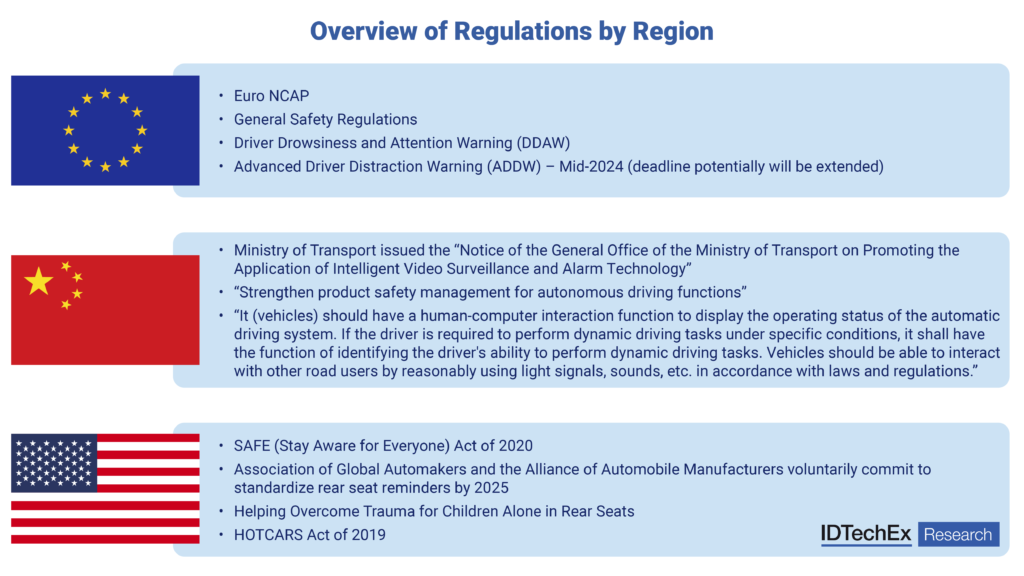Driver monitoring systems (DMS) have gained considerable momentum, driven by the escalating SAE autonomous driving levels and regulatory frameworks in key regions like the USA, Europe, China, Japan, and others. While DMS is not a novel concept, traditional DMS techniques typically rely on passive data sourced from advanced driver-assistance systems (ADAS), such as driving duration and lane-keeping. Although these conventional passive technologies offer simplicity and easy integration into vehicles, they are prone to generating false positives.
In contrast, emerging regulations, such as the advanced driver distraction warning (ADDW) mandated by the European Commission (EU), necessitate the incorporation of active monitoring to observe drivers’ eye movements. This article aims to provide an overview of regulations across major regions, elucidating their impact on the adoption of DMS components. This article shares some of the research from the brand new IDTechEx market research report, “In-Cabin Sensing 2024-2034: Technologies, Opportunities and Markets”.

Europe
Europe is among the regions with clearly defined regulations mandating the installation of vision-based Driver Monitoring Systems (DMS). Established in 2019 by the EU General Safety Regulation (GSR), all motor vehicles falling under categories M and N are required to be equipped with Driver Drowsiness and Attention Warning (DDAW) systems. This regulation applies to new types of vehicles from July 6, 2022, and to all new vehicles from July 7, 2024. Specifically, DDAW must identify driving and/or steering patterns indicative of a driver experiencing reduced alertness due to fatigue. It is designed to interact with and alert the driver through the vehicle’s human-machine interface, primarily utilizing passive sensing technologies like steering patterns.
As regulations become more stringent, the EU introduced additional requirements. According to the second set of documents, all new types of vehicles must incorporate an Advanced Driver Distraction Warning (ADDW) system. This requirement is effective from mid-2024 for motor vehicles falling under categories M and N for new types and from July 7, 2026, for all new vehicles. In contrast to DDAW, which primarily monitors steering patterns, the ADDW system focuses on observing driver eye movements and issues warnings when distractions are detected.
Beyond the GSR, the European New Car Assessment Programme (Euro NCAP) mandates the inclusion of a direct DMS for a five-star rating. While both Euro NCAP and GSR necessitate DMS installation, Euro NCAP demands more detailed information to detect specific types of distractions, including short multiple distractions. In contrast, the GSR concentrates solely on the detection of prolonged distractions.
USA
The United States has implemented several driver monitoring systems (DMS) regulations. In 2020, the SAFE (Stay Aware for Everyone) Act was introduced during the 116th Congress, directing the Secretary of Transportation to explore the use of DMS to mitigate or eliminate distractions for motor vehicle drivers.
Beyond regulatory mandates, IDTechEx has observed various initiatives from automotive original equipment manufacturers (OEMs) aimed at integrating DMS and occupant monitoring systems (OMS). Notably, in the U.S., a coalition of automakers has voluntarily committed to incorporating rear-seat reminder systems in virtually every new car sold in the country by the 2025 model year, as indicated by two industry lobbying groups.
Additionally, in 2019, the U.S. Congress put forth the Hot Cars Act (Helping Overcome Trauma for Children Alone in Rear Seats). This proposed legislation aims to mandate rear-seat occupant monitoring to prevent incidents of children being inadvertently left in hot vehicles.
China
China has issued several documents aimed at enhancing product safety management for autonomous driving functions. In 2020, the country introduced performance requirements and test methods for driver attention monitoring systems, encompassing experiments such as eye closure, yawning, head position, and cell phone usage. Subsequently, in October 2020, China officially released the recommended national standard GB/T 41797-2022, titled “Driver Attention Monitoring System (DAMS) Performance Requirements and Test Methods,” which took effect in May 2023. This standard outlines five types of distracting behaviors and associated alert conditions. DAMS is required to incorporate, at a minimum, monitoring for the first three behavior types (eye closure, abnormal head posture, and answering phone calls). If DAMS includes monitoring for the last two behavior types (yawning and smoking), it must also satisfy the corresponding requirements.
Japan
Released in May 2023, the Ministry of Economy, Trade and Industry (METI) and the Ministry of Land, Infrastructure, Transport and Tourism (MLIT) have jointly been advancing a series of validation tests to achieve automated driving mobility services since FY2021. One of the safety requirements is driver condition monitoring, where autonomous vehicles are required to monitor to see if the driver is ready to take over driving from the system and issue an alarm as necessary.
Summary
Given the regulatory requirements, IDTechEx anticipates that major automotive companies will expedite the integration of Driver Monitoring Systems (DMS), presenting significant opportunities across the entire supply chain. This includes tier-one suppliers, software solution providers, and component suppliers such as infrared cameras, time-of-flight cameras, radar, and others. With a clearly defined timeline in place, IDTechEx envisions rapid market growth in the field of in-cabin sensing, encompassing DMS, OMS (Occupant Monitoring Systems), and more. The projected annual market size is estimated to reach approximately US$8.6 billion by 2034. For a comprehensive understanding of the regulations, sensor technologies, and market adoption, IDTechEx offers detailed insights in their latest research report titled “In-Cabin Sensing 2024-2034: Technologies, Opportunities and Markets”.















